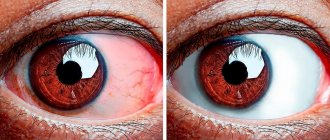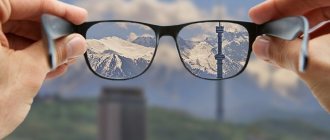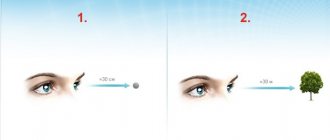Myopia, or myopia, occurs in adults and children and progresses rapidly without proper treatment.
To get rid of it or stabilize the condition, various correction methods are used - laser, optical, the use of intraocular lenses, hardware and physiotherapy.
It is also recommended to do eye exercises, give the organ of vision a break, and alternate rest with work. It is possible to use folk remedies, vitamin preparations and other methods to improve the patient’s condition.
Optical correction
Special biconcave “minus” lenses are selected by a doctor and worn, which refract the light beam and focus it on the retina of the eye. Depending on your vision, a prescription is written with the required diopters.
We recommend reading: Diopters for myopia
As a result of optical correction, myopia is not cured, but the condition is stabilized for some time. A person's vision is restored when wearing glasses and contact lenses, the blurring of objects is reduced, and distance vision is improved.
Degrees and types of myopia
Visual clarity is measured in diopters. When determining the degree of myopia, the ophthalmologist focuses on the amount of vision deviation from the norm. There are three degrees of myopia:
- Weak – visual clarity is no more than 3 diopters.
- Average - from 3 to 6 diopters.
- High – more than 6 diopters.
With severe myopia, there is a significant decrease in vision, which significantly reduces the patient’s quality of life. In addition, this pathology poses a serious danger to eye health, as it can provoke various complications. These include:
- Frequent headaches.
- Deterioration in coordination of movements.
- Inability to view objects in low light.
- Retinal detachment, which can lead to complete loss of vision.
There are three types of myopia:
- Congenital – diagnosed in newborn babies.
- Hereditary - occurs in people whose parents suffer from myopia. Hereditary myopia is characterized by early development - as a rule, it is diagnosed in children from 1 to 18 years.
- Acquired - the cause of this type of pathology is eye strain as a result of constant visual stress, insufficient lighting of the workplace, failure to maintain the optimal distance between the eyes and a book or notebook. Most often, the acquired form of myopia develops in children from 7 to 16 years old.
In addition, the disease can be stationary or progressive. With stationary myopia, vision deterioration does not occur for a long time. The progressive form is characterized by a constant decrease in vision.
There is another type of myopia – false myopia. It is caused by weakening of the ciliary muscles due to eye strain or the use of certain types of eye drops. According to statistics, this pathology occurs in 15% of children.
Orthokeratology
This method of treating myopia, based on the use of orthokeratological (rigid gas-tight) lenses, is otherwise called night correction. It gives a stable but temporary effect.
Special ones are put on at night and taken off in the morning. As a result, the lenses put pressure on the cornea, and it changes its shape. Changes persist throughout the day, sometimes longer. The correct angle of light refraction is ensured, the image is accurately focused on the retina of the organ of vision and a person sees objects better.
The frequency of wearing lenses is determined individually. As visibility deteriorates, you can again put on the CL at night.
Orthokeratological correction of myopia is used in adults and children.
Food
How can you get rid of myopia without surgery? Traditional medicine offers its own options for improving vision.
Below are recipes that contain only natural products that are very easy to find:
- Take walnuts and fresh apricots in equal proportions. Crumble them into a uniform mass. Add 2 teaspoons of honey to a glass of this mixture and stir. Eat two tablespoons of the mixture per day (you can wash it down with water if desired).
- Grate the carrots on a fine grater, add buckwheat honey, stir. Eat after lunch instead of dessert.
- Take 2 cups of lingonberries and 1 cup of honey. Grind the ingredients and eat three tablespoons a couple of times a day.
- Fresh chokeberry, eaten on an empty stomach (maybe with honey), is very beneficial for vision.
- Sea buckthorn is a storehouse of nutrients and vitamins that are beneficial both for the body as a whole and for vision. Drink sea buckthorn oil one tablespoon per day for two weeks.
- Schisandra tincture: place 1 part of a mixture of lemongrass fruits and seeds in a dark glass container and fill with 10 parts of 70% medical alcohol. Leave for three weeks. Take 30 drops before meals for 14 days in a row. Take a break for a week, repeat the course if necessary.
- Ginger tincture (improves vision and relieves eye strain): place 75 g of ginger powder in a glass container and pour 2 glasses of vodka. Leave in a cool, dark room for a couple of weeks. Strain the finished tincture and take one teaspoon before meals (with a glass of cool boiled water) twice a day.
Laser correction
Myopia correction using laser is carried out from 18 to 45 years of age; it is not recommended at earlier or later ages. For this purpose, special equipment is used that does not come into contact with the surface of the human eye. The most famous and effective technique is LASIK.
The advantages of laser correction are effectiveness, painlessness, and the absence of a protracted rehabilitation period. The day after surgery, a person can see the world in a new way.
The technology for treating myopia is performed without a knife. First, the device cuts off a thin flap from the cornea and folds it back. Unnecessary corneal cells are evaporated from the exposed surface with a laser and then covered with a flap. Due to this manipulation, the structure of the eye is modified, its relief, curvature and refractive ability of the membrane of the organ of vision are improved.
After laser correction, it is necessary to adhere to the recommendations of the ophthalmologist, possibly change your lifestyle, and reduce the load on the organ of vision. When exposed to factors that provoke myopia, myopia may return.
Are there complications after laser treatment for myopia?
The listed procedures are safe, but sometimes complications arise. After LASIK they occur only in 1-5% of cases. Complications should not be confused with temporary side effects, which include:
- blurred vision at dusk;
- pain;
- lacrimation;
- photophobia;
- drooping upper eyelid;
- swelling;
- redness of the eye.
All these symptoms disappear in a day or two. Some patients do not notice them 2 hours after the procedure. There are also complications that lead to changes in vision:
- displacement of the corneal flap;
- ingrowth of the epithelium under the upper layer of the cornea;
- keratitis;
- overcorrection or undercorrection.
All these complications, except for keratitis, which is an inflammatory disease of the cornea, are eliminated during reoperation.
Implantation of intraocular lenses
Intraocular lenses, or artificial lenses, are used in cases where other treatment is not indicated. For example, age over 45 years (limit up to 65 years), myopia over 15 diopters.
To do this, the natural human lens is surgically removed and an intraocular lens is implanted in its place through a minimal incision. The advantage of the procedure is safety, protection from possible infections. Additionally, this method of correcting myopia can relieve cataracts and astigmatism.
Surgical methods for treating myopia in adults
How to treat myopia if laser surgery is contraindicated? There are two main surgical methods that can get rid of even very severe forms of myopia:
- installation of phakic lenses;
- replacement of the lens with an intraocular lens (IOL).
The first technique is one of the most modern. Phakic lenses are those that are placed under the cornea just in front of the lens. This changes its refractive power. Such ophthalmic products are almost no different from conventional contact optics. However, they are installed for a longer period of time, sometimes for the rest of your life. To remove the lens or adjust its optical power, that is, replace it, you have to undergo surgery again.
Lens replacement is a more radical way to treat myopia. An adult, especially after 60 years of age, may develop cataracts due to myopia, in which the lens becomes cloudy. Its light transmittance deteriorates. This leads to severe vision loss. If this pathology is not treated on time, the patient will go blind.
Physiotherapy
To strengthen the eye muscles and prevent and treat myopia, hardware and physiotherapeutic treatment is used. The most famous and recommended devices are “Vibrotod”, “Vizulon”, “Visotronic”.
Hardware treatment is prescribed for adults and children.
The Visotronic device can be used in the clinic and at home. It relaxes the eye muscles, increases visual acuity, and helps reduce the negative effects of excessive visual stress. The action is based on installed special lenses.
The Vibrotod device is a vibration massager that stimulates the facial muscles, respectively, the work of the lens and the eye as a whole.
The Vizulon device is based on a color signal of varying intensity and frequency that affects nerve endings. The mode is selected individually, there are 40 variations in total.
Use of medicinal plants
Is it possible to get rid of myopia with the help of medicinal plants? Yes, it's possible. This treatment should be carried out in parallel with taking tinctures. In general, treatment of myopia at home involves the use of medicinal herbs in the form of drops, compresses, lotions, as well as decoctions and infusions taken orally:
- Pour 2 tablespoons of crushed eyebright with two cups of boiling water. Leave for 20 minutes, then strain and drink three times a day before meals.
- Blueberry juice drops: dilute freshly squeezed blueberry juice with boiled water in a 1:2 ratio. Use the resulting solution as eye drops, placing 5 drops in each eye. It is better to carry out the procedure in the morning - after the morning toilet.
- Eyebright drops: pour 1 tablespoon of the herb into 100 ml of boiling water and leave for 20 minutes. Then strain and place 1 drop in each eye.
- Honey drops: dilute 0.5 teaspoon of honey in boiled water. Apply the solution as follows: drop two drops into each eye three times a day. Store in the refrigerator for no more than 2 days.
- Chamomile infusion: pour a cup of boiling water over the flowers, leave for half an hour, strain. Drink ½ glass of infusion four times a day.
- Mix a couple of tablespoons of calamus root, a couple of tablespoons of cornflower flowers, three tablespoons of dandelion, one of fragrant rue root, four tablespoons of blueberry leaves. Store the collection in a glass container with a closed lid. Pour boiling water (300 ml) into three tablespoons of the herbal mixture and simmer in a water bath for 10 minutes. Cool, strain through a couple of layers of gauze or thick cloth. Use the drug in the form of drops: two pieces in each eye three times a day.
- Plantain decoction: pour 2 teaspoons of crushed plantain leaves into a cup of boiling water and put on fire. Bring to a boil, stirring constantly, and immediately remove from the stove. Cool the broth, strain and squeeze out the leaves. Drink ½ cup three times a day before meals.
- Place 50 g of eyebright, 200 g of aloe, 50 g of dried blue cornflower flowers, 600 g of natural honey into an enamel pan. Pour a bottle of dry red wine, stir and place in a water bath. Simmer covered for one hour. Turn off the burner, cool and strain the medicine into a glass jar with a lid. Store in the refrigerator. Take 1 tablespoon half an hour before meals three times a day.
Gymnastics for the eyes
Simple exercises that do not require special training can improve visual acuity and reduce eye fatigue, especially with excessive visual stress. They strengthen the eye muscles, stimulate the visual centers of the brain and improve focusing.
There are many methods for restoring vision based on eye gymnastics. The most effective, simple and easy exercises:
- movements of the eyeballs left-right and up-down;
- rotation of the eyes clockwise and back;
- rapid blinking for one minute;
- closing your eyes, then opening them after 5 seconds, repeating the exercise for a minute;
- bringing the gaze to the bridge of the nose;
- movement of the eyeballs from top to right down to the left and back.
It is useful to look at objects in the distance. To do this, select an object that is far away in the window and look at the nearest object.
Two more effective exercises for improving focus and relieving fatigue are palming and the Bates short swing.
How to do exercises while standing?
How to get rid of myopia on your own? There are exercises that can be performed while standing (place your feet shoulder-width apart, look ahead):
- Hold your gaze on any object placed in front of you. It should be at eye level at a distance of 1.5-2.5 m (for example, it could be a picture hanging on the wall). Extend your arm forward at eye level, make a fist and bend your thumb up. Fix your gaze on your finger for 5 seconds. Focus your gaze alternately on the distant object you have highlighted, then on the finger of your outstretched hand. Perform the exercise 10-15 times.
- Extend your hand forward at eye level, clench your fingers into a fist and extend only your index finger. Fix your gaze on your finger. Slowly bring your hand closer to your eyes, trying not to take your eyes off your finger until it begins to double. Repeat the exercise 10-15 times.
- Place your index finger opposite the bridge of your nose at a distance of 30 cm from your face. Hold your gaze on your finger for 5 seconds. Cover your left eye with the palm of your free hand and focus your gaze on your finger. Remove your palm from your face and focus on your finger with both eyes. Do the same with your right hand (you can change your hand). Repeat 10 times.
- Move your right half-bent arm to the side with your index finger or thumb extended upward. Fix your gaze on him without turning your head. Move your finger imperceptibly from right to left, following it with your gaze. Repeat the exercise 10-15 times.
Treatment without surgery at home
To maintain visual acuity, stabilize the condition and improve visibility in myopia, you should normalize your diet by including the necessary vitamins, minerals and antioxidants. Folk remedies have a beneficial effect on the eyes, the feasibility of which and their benefits/harms should be discussed with a specialist.
Diet
The development of myopia and deterioration of vision is influenced by poor nutrition. To normalize and improve the condition, it is necessary to consume protein contained in fish, meat and eggs. Vegetables and fruits that are beneficial for the organ of vision are recommended to be eaten raw. During heat treatment, beneficial substances are lost.
Important vitamins for myopia are A, D, E, B. Minerals are also necessary - copper, chromium, zinc and magnesium.
If you have myopia, you should exclude coffee, strong tea, cocoa, sausages, and canned goods.
Blueberry
Berry extract is part of many vitamin complexes: Myrtilene forte, Blueberry forte, Blueberry. The berries themselves, fresh or frozen, are also useful. They contain bioflavonoids, which have an antioxidant effect, reduce damage to the organ of vision and the body as a whole by free radicals.
They improve visual acuity, restore the light-sensitive pigment rhodopsin, stimulate microcirculation and nutrition of eye tissue. Additionally, they make the retinal capillaries elastic and strong.
You can take 100 g per day to improve vision, brew with boiling water in the proportion of 2 tbsp per 600 ml of hot water. l. berries or taken in the form of tablets and capsules. The course of therapy is long - 1-3 months.
Carrot
Source of carotenoids and vitamin A, beneficial for vision. Helps improve visual acuity, supports retinal functionality and rhodopsin synthesis. It also protects the lens from destruction.
Vitamins are better absorbed in combination with fats, so you should add 1 tbsp to 200 ml of carrot juice. l. olive oil. Take it every day for a long time.
Ginkgo biloba
The plant, which improves blood supply and microcirculation of eye tissue, is an antioxidant. It is sold in pharmacies in dry form and is included in the preparations: Ginkum, Ginkgo biloba, Bilobil.
In ophthalmological practice it is used to improve nutrition of the oculomotor and ciliary muscles, increase visual acuity, and ensure blood flow to the retina.
Polyunsaturated fatty acids
For normal eye function, the body requires a daily intake of polyunsaturated fatty acids, or omega-3s. Their source is sea fish and algae. Also included in dietary supplements - Doppelgerz Omega-3, Omega-3-6-9, Omeganol, Fish oil.
Additionally, it prevents the development of atherosclerosis.
Calcium
To inhibit the growth of the eye in length, it is necessary to strengthen the sclera. One way to do this is to consume dairy products and other foods or supplements that contain calcium.
Eyebright
Medicinal raw materials are sold in pharmacies and help with decreased visual acuity, eyeball injuries, and various inflammatory processes. Eyebright is used as a decoction and lotions. For this, 2 tbsp. l. pour dry raw materials with a glass of boiling water and leave for 25 minutes.
Bee products
Propolis and honey are actively used to prepare lotions, infusions and eye drops at home. When using them, you must make sure that you are not allergic to bee products.
Propolis in the amount of 1 tsp. dissolve in a glass of boiled water, filter the resulting solution and store in a dark, cool place, for example, a floor cabinet. The resulting product is used in the form of compresses or eye drops. Before use, you should consult an ophthalmologist.
Causes of myopia
Myopia is very common. According to statistics, more than 1 billion people on the planet suffer from myopia. The most common causes of myopia are:
- Irregular shape of the eyeball - when the length of the anteroposterior axis of the eye is greater than normal, and light rays, when focused, simply do not reach the retina. With an elongated shape of the eyeball, the posterior wall of the eye is stretched, and this state of the visual system can provoke changes in the fundus of the eye.
- Too strong refraction of light rays by the optical system of the eye (lens, cornea). In this case, the size of the eye corresponds to the norm, but due to strong refraction by the optical apparatus, light rays converge into focus in front of the retina, and not on it.
In addition to the causes of myopia, ophthalmologists also identify factors that can influence the development of this disease.
- Hereditary factor. According to experts, it is not poor vision that is inherited, but a physiological predisposition to it. Those at risk are those who have both parents suffering from this disease. The presence of myopia in only one of the parents reduces the likelihood of myopia by 30%.
- Weakening of the scleral tissue leads to an increase in the size of the eyeball under the influence of high intraocular pressure (18–24 mmHg) and, as a result, contributes to the development of myopia.
- Primary weakness of accommodation, leading to compensatory stretching of the eyeball.
Weakening of the body as a result of poor nutrition, overwork, and a number of diseases. Such as:
- violation of the musculoskeletal system: flat feet, scoliosis, etc.;
- allergic and infectious diseases: measles, scarlet fever, diphtheria;
- tuberculosis, infectious hepatitis, etc.;
- birth injuries;
- brain injuries;
- diseases of the nasopharynx and oral cavity: tonsillitis, sinusitis, adenoids; rickets;
- general decrease in immunity.
Unfavorable visual working conditions:
- Excessive strain on the eyes, eye strain;
- Reading in a moving vehicle, in the dark, while lying down;
- Sitting for many hours at the computer, TV;
- Insufficient lighting;
- Incorrect sitting position while reading and writing.
Useful video
Exercises to improve vision - 10 effective ways to influence myopia and restore visual acuity of objects.
Author's rating
Author of the article
Alexandrova O.M.
Articles written
2031
about the author
Was the article helpful?
Rate the material on a five-point scale!
( 1 ratings, average: 5.00 out of 5)
If you have any questions or want to share your opinion or experience, write a comment below.











